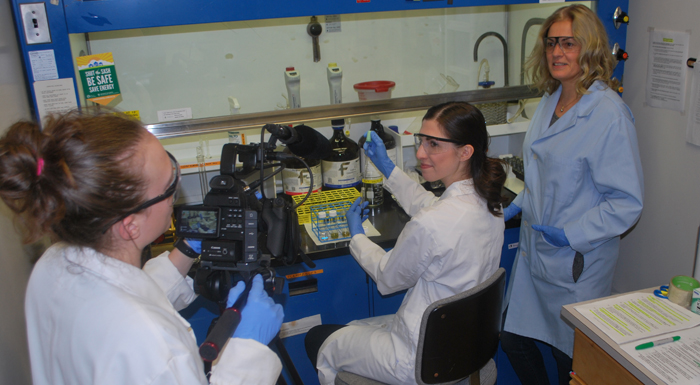
Whether you're a mechanic or a musician, if you want to learn a tricky technique these days you look for an online video that explains it. Scientists are no different - although their videos demand a higher degree of credibility.
Which is why a videographer sent by the Journal of Visualized Experiments in Cambridge, Mass., was filming in soil scientist Sylvie Quideau's lab earlier this month.
The journal, also called JoVE, was founded in 2006 to publish peer-reviewed scientific research in a visual format to help researchers learn new experimental techniques, while also helping to ensure they are applied in a standardized fashion, worldwide.
"This is absolutely the way science is moving forward," said Quideau, a professor of soil biogeochemistry in the Department of Renewable Resources.
"They are publishing many protocols in video format. I hope some of my other colleagues embrace the idea and do the same, as I find it extremely useful when I want to use a new protocol … the way we communicate as scientists is changing. "
In Quideau's case, JoVe filmed her protocol for extracting phospholipid fatty acids (PLFAs) from soil samples in order to learn about the overall structure of the soil's microbial communities. The PLFAs provide an index of soil quality and how soils respond to disturbances.
The PLFA method is commonly used by many microbial ecology laboratories around the world and has been documented in print many times, said Quideau. However, in an about-to-be published video article, she presented an easy-to-follow protocol that's quantitative and reproducible for soil scientists who are trying to learn the technique.
While there are four main steps, each includes dozens of smaller tasks to master. Otherwise, the soil samples can be rendered useless, said Quideau.
"For a new user, if you actually see it being done, it's easier to follow," she said.
Quideau says JoVe chose to document her protocol on video because soil scientists in her group in the Faculty of ALES have published many papers using this technique over the past decade. These include studies on soil reclamation in the oilsands, research on the effect of different harvesting practices, and work on the influence of management on prairie soils.
"We are a strong team," said Quideau, noting that the department is home to an array of experts in soil physics and environmental chemistry, too.
"Our strength is in restoration and reclamation. This is where we are unique in Canada."
Which is why a videographer sent by the Journal of Visualized Experiments in Cambridge, Mass., was filming in soil scientist Sylvie Quideau's lab earlier this month.
The journal, also called JoVE, was founded in 2006 to publish peer-reviewed scientific research in a visual format to help researchers learn new experimental techniques, while also helping to ensure they are applied in a standardized fashion, worldwide.
"This is absolutely the way science is moving forward," said Quideau, a professor of soil biogeochemistry in the Department of Renewable Resources.
"They are publishing many protocols in video format. I hope some of my other colleagues embrace the idea and do the same, as I find it extremely useful when I want to use a new protocol … the way we communicate as scientists is changing. "
In Quideau's case, JoVe filmed her protocol for extracting phospholipid fatty acids (PLFAs) from soil samples in order to learn about the overall structure of the soil's microbial communities. The PLFAs provide an index of soil quality and how soils respond to disturbances.
The PLFA method is commonly used by many microbial ecology laboratories around the world and has been documented in print many times, said Quideau. However, in an about-to-be published video article, she presented an easy-to-follow protocol that's quantitative and reproducible for soil scientists who are trying to learn the technique.
While there are four main steps, each includes dozens of smaller tasks to master. Otherwise, the soil samples can be rendered useless, said Quideau.
"For a new user, if you actually see it being done, it's easier to follow," she said.
Quideau says JoVe chose to document her protocol on video because soil scientists in her group in the Faculty of ALES have published many papers using this technique over the past decade. These include studies on soil reclamation in the oilsands, research on the effect of different harvesting practices, and work on the influence of management on prairie soils.
"We are a strong team," said Quideau, noting that the department is home to an array of experts in soil physics and environmental chemistry, too.
"Our strength is in restoration and reclamation. This is where we are unique in Canada."